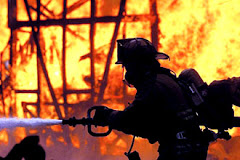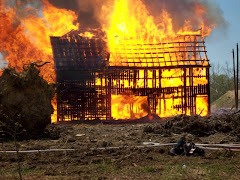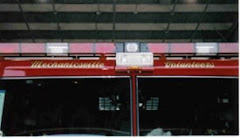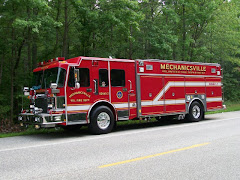Often, the main way to extinguish a fire is to spray with water. The water has two roles:
in contact with the fire, it vaporizes, and this vapour displaces the oxygen (the volume of water vapour is 1,700 times greater than liquid water); leaving the fire with not enough combustive agent to continue, and it dies out.
the vaporization of water absorbs the heat; it cools the smoke, air, walls, objects in the room, etc., that could act as further fuel, and thus prevents one of the means that fires grow, which is by "jumping" to nearby heat/fuel sources to start new fires, which then combine.
The extinction is thus a combination of "asphyxia" and cooling. The flame itself is suppressed by asphyxia, but the cooling is the most important element to master a fire in a closed area.
Open volume fire
For fires in the open, the seat of the fire is sprayed with a straight spray: the cooling effect immediately follows the "asphyxia" by vapor, and reduces the amount of water required. A straight stream (or solid spray) is used so the water arrives massively to the seat of the fire without being vaporized. A high presure spray may also have a mechanical effect: it can disperse the combustible product and thus prevent the fire from starting again.
Spray is aimed at a surface, or object: for this reason, the strategy is sometimes called two-dimensional attack or 2D attack.
It might be necessary to protect specific structures (house, gas tank) against infrared radiation, and thus use a fog patern (or diffused spray) between the fire and the object.
Closed volume fire
Until the 1970s, building fires were usually attacked form the outside, so the same strategy as for open air fires was effective. In recent times, fires are now attacked form the inside during their development phase. Interior attack is commen now because; firefighters can arrive sooner, thermal insulation of houses confines the heat to the inside, and firefighters have equipment that allows them to work inside a burning building(i.e. SCBA, turnout gear...). Additionally, in these conditions, there is a greater risk of backdraft and of flashover.
Spraying of the seat of the fire directly can have unfortunate and dramatic consequences: the water pushes air in front of it, so the fire is supplied with extra oxygen before the water reaches it. This activation of the fire, and the mixing of the gases produced by the water flow, can create a flashover.
The most important issue is not the flames, but control of the fire, i.e. the cooling of the smoke that can spread and start distant fires, and that endanger the lives of people, including firefighters. The volume must be cooled before the seat is treated. This strategy originally of Swedish (Mats Rosander & Krister Giselsson) origin, was further adapted by London Fire Officer Paul Grimwood following a decade of operational use in London's busy west-end district between 1984-94 and termed three-dimensional attack, or 3D attack.
Use of a fog patern (or diffused spray) was first proposed by Chief Lloyd Layman of Parkersburg, West Virginia Fire Department, at the Fire Department Instructor's Conference (FDIC) in 1950 held in Memphis, Tennessee, U.S.A.
Using Grimwood's modified '3D attack strategy' the ceiling is first sprayed with short pulses of a diffused spray:
it cools the smoke, thus the smoke is less likely to start a fire when it moves away;
the pressure of the gas drops when it cools (law of ideal gases), thus it also reduces the mobility of the smoke and avoids a "backfire" of water vapour;
it creates an inert "water vapour sky" which prevents roll-over (rolls of flames on the ceiling created by the burning of hot gases).
Only short pulses of water must be sprayed, otherwise the spraying modifies the equilibrium, and the gases mix instead of remaining stratified: the hot gases (initially at the ceiling) move around the room and the temperature rises at the ground, which is dangerous for firefighters. An alternative is to cool all the atmosphere by spraying the whole atmosphere as if drawing letters in the air ("pencilling").
The modern methods for an urban fire dictate the use of a massive initial water flow, e.g. 50 gallons/min for each fire hose. The aim is to absorb as much heat as possible at the beginning to stop the expansion of the fire, and to reduce the smoke. When the flow is too small, the cooling is not sufficient, and the steam that is produced can burn firefighters (the drop of pressure is too small and the vapor is pushed back). Although it may seem paradoxical, the use of a strong flow with an efficient fire hose and an efficient strategy (diffused sprayed, small droplets) requires a smaller amount of water: once the temperature is lowered, only a limited amount of water is necessary to suppress the fire seat with a straight spray. For a living room of 50 m² (60 square yards), the required amount of water is estimated as 15 gallons.
French fire-fighters used an alternative method in the 1970s: they sprayed water on the hot walls to create a water vapour atmosphere and asphyxiate the fire. This method is no longer used because it was risky: the pressure created pushed the hot gases and vapour towards the firefighters, causing severe burns, and pushed the hot gases into other rooms where they could start a new fire.
Asphyxiating a fire
In some cases, the use of water is undesirable: some chemical products react with water and produce poisonous gases, or even burn in contact with water (e.g. sodium);
some products float on water, e.g. hydrocarbon (gasoline, oil, alcohol, etc.); a burning layer can then spread and extend;
in case of a pressurised gas tank, it is necessary to avoid heat shocks that may damage the tank: the resulting decompression may produce a BLEVE.
It is then necessary to asphyxiate the fire. This can be done in two ways:
some chemical products react with the fuel and stop the combustion;
a layer of water-based fire retardant foam is projected on the product by the fire hose, to keep the oxygen in air separated from the fuel.
wikipedia.org















